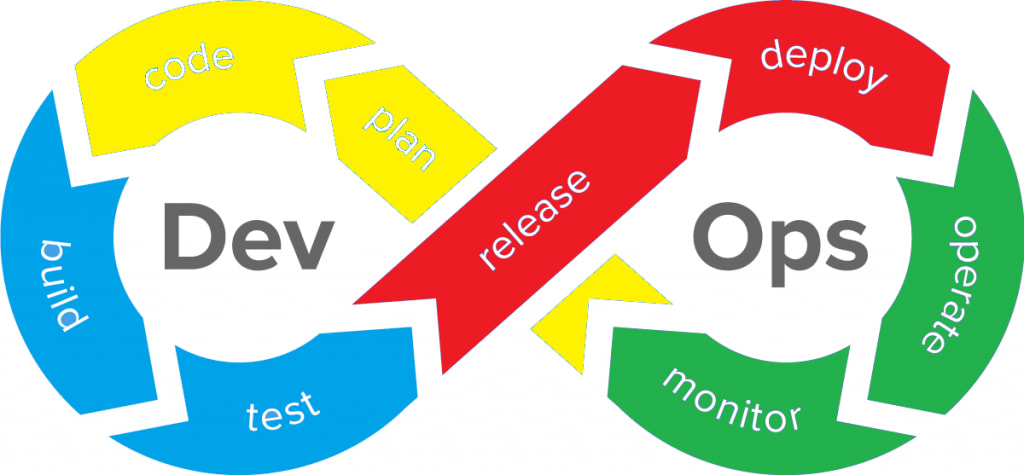DevOps: A New Perspective on Shared Automation
What is DevOps?
DevOps is a set of various tools, practices, and ideals that combine software development (Dev) and IT Operations (Ops) into a single unifying force. It allows for better collaboration between developers, operations teams, system administrators, and system engineers. Their streamlined goal is to continually provide a high-value software product to the customer at high speed while monitoring and improving the overall process than using traditional software and infrastructure management.
What is the Purpose of DevOps?
The purpose of DevOps, in general, is to improve the speed of the entire production process in addition to increasing the quality of work performed. DevOps has to communicate with various departments inside the company and with the customers to deliver high-value products. In that regard, we can say that DevOps is becoming a core element of product development.
Alternatively, I liked Emily Fredman’s definition in her book DevOps for Dummies. She describes it as “an engineering culture of collaboration, ownership, and learning to accelerate the software development life cycle from ideation to production.” As she points out, DevOps can be extremely helpful in eliminating bottlenecks in the production process, decreasing tension and friction between the team(s), while improving team collaboration, which can drastically improve efficiency and productivity.

Goals of DevOps
Well implemented DevOps practices can help us achieve vital business goals including:
- Accelerate product development to the market
- Faster adaptation to the market and competition
- Improve system stability and reliability
- Improve time of recovery in case of system failures
History of DevOps
In essence, DevOps has its roots in Agile software development, which itself evolved to replace the so-called waterfall development. The Manifesto for Agile Software Development was published in 2001, and it laid out a foundation for a new method of development, which drastically changed software development.
However, Agile failed in creating a bridge between two silos -- developers and the operations team, and this needed to change. Enter 2008, when Andrew Clay Shafer and Patrick Debois organized the first DevOpsDays, which took place in Belgium to “evolving” Agile to create a bridge between two siloed teams. Ever since then, DevOps has been increasing in popularity as it has become a vital component of software development production environments in companies around the world.
Benefits of DevOps?
Besides the improvements, as mentioned earlier in the relation between developers and operations teams, a single DevOps team can also provide technical advancements in the product development process. CI/CD (Continuous Integration/Continuous Delivery) is closely related to DevOps, and it can help decrease or ideally remove bottlenecks that can occur in code deployments. DevOps also enables faster resolution of problems and improved handling of incidents (that will happen for sure) compared to the standard approach in software development. This is due to the nimble, lean nature of the DevOps team that results in better coordination and monitoring of code deployments.
Having a DevOps team can also significantly improve company culture. That’s primarily focused on possible improvements in communication between various departments (especially development and operations teams), which leads to higher employee engagement and a less stressful work environment.
Lastly, all this leads to multiple benefits in the business itself. Customers will be happier, new features will be released quicker, and reliability of the software/infrastructure will be improved (which frees up more time from maintaining the product/infrastructure to focus on faster product innovation). It will essentially remove the bottlenecks in the development and deployment process while improving the usage of resources that the organization already has but is maybe not utilizing correctly due to the lack of a dedicated DevOps team.
Why DevOps Matters
In today’s world, almost every company is a tech company. Software applications and the Internet are transforming the way every industry operates and performs. Software and the Internet are not an addition to the business as they were 20 years ago, today they are essential elements.
DevOps is playing one of the most critical roles in this transformation. Technological advancements are occurring daily, and the IT sector is a continually evolving environment. Today, the only constant in business is change. In our fast-paced and ever-changing world, DevOps enables organizations to rapidly adapt to growth and stay competitive.
In this process, an organization needs to establish an ample culture of learning. Demand for great engineers is evolving, and it is the organization’s imperative to create an innovative and encouraging environment that will prioritize the growth mindset of engineers. DevOps teams are becoming critical in an organization’s structure, and this team must have good chemistry to avoid friction, especially when faced with issues. Good interpersonal relationships will improve productivity, deliver better products, and increase customer satisfaction, and the company will stay competitive.

Implementing DevOps
The road of transforming to DevOps can be bumpy for everyone in the organization. One of the biggest challenges in the process is balancing culture with technology. Flawed cultural foundations can cause significant issues down the road. Thus, it is vital to establish a collaborative, trustful, and supportive environment for employees. Even good technological improvements in the company will not make up for issues from bad cultural practices.
Another pitfall in the process can be a lack of measuring the process of DevOps transformation. It is of utmost importance to create specific indicators and measurable data sets, such as deployment frequency, employee and customer satisfaction, infrastructure uptime, customer tickets, SLAs, etc. With useful data, a company can adjust itself and continuously improve internal processes.
Lastly, since the road to DevOps transformation can get quite bumpy, it is essential to adjust this process's speed per the company’s environment. Change can be useful, but making too many changes in a short time can cause significant damage. DevOps is very beneficial over the long term, so it is needed to give some breathing space to everyone involved to avoid burnouts. DevOps cannot remove all the challenges in software development and deployment. It enables everyone to do the best job possible, but too many changes will only cause overwhelming pressure.
DevOps Engineer
In the product development cycle, developers and operations teams are usually focused on their respective roles, which essentially creates “silos.” There can be inadequate communications between the two, which increases friction and decreases efficiency. This is where DevOps engineers “step in” -- their job is to build (or be) a bridge between the two. Ideally, DevOps engineer has experience in software development, but also operations (system administration). Simply put, a DevOps engineer is a person that closely works with the Development and Operations team to successfully “supervise” code releases. All those skills enable DevOps engineers to improve CD/CD pipelines within the organization drastically.
Also worth mentioning is that job titles can vary, depending on the organization. Additionally, there are similar job titles whose job descriptions can overlap with DevOps engineers’ job descriptions. Those jobs might be Release engineer, Site reliability engineer, Automation engineer, etc.
DevOps Tools
There are many available tools in DevOps to be used in the process of DevOps product development, deployment, and monitoring. These tools can drastically improve the sharing of information and resource planning between various teams, assign tasks to individuals or groups, improve product/service delivery, clarify testing, integration, and monitor the infrastructure. Choosing the right tools for specific purposes can vastly improve overall output and productivity while decreasing friction and ensuring maximum infrastructure uptime. Here is a list of some of the most common DevOps tools.
Communication, Collaboration and Planning
These tools promote one of the most important aspects of the DevOps process: team, company, client communication, collaboration, and planning.
- Jira - a tool used for collaboration, planning, managing projects, and tracking issues that might occur.
- Clarizen – An SaaS project management tool.
- Slack – A messaging platform for real-time communication between teams.
- Basecamp – A tool used for project management and real-time communication between teams.
- Asana – A platform that organizes, tracks, and manages workflows.
- Trello – A team management application that helps keep track of all tasks and project progress.
Development Tools and Environments
Development tools and environments are programming tools to build and test software. Some can be very sophisticated and integrate other categories, such as continuous integration, deployment, or monitoring. Some leading tools in this category are:
- Docker – A tech suite that makes it easier for companies to build, distribute, and run containers (distributed applications).
- Kubernetes – A container orchestration system used for coordination.
- Puppet Enterprise – A configuration management tool that runs the infrastructure as code.
- Ansible – A tool that automates the entire application lifecycle.
- Spinnaker - An open-source, multi-cloud continuous delivery platform for releasing software changes
- Vagrant – A tool used to streamline software configuration management for virtualized environments.
- Chef – A cloud automation tool for configuration management.
- Gradle – An open-source build-automation system that uses a Groovy-based domain-specific language (DSL) and Java instead of XML.
- CodePen – A code editor for front-end development using HTML, CSS, and JavaScript.
- TypeScript – An open-source programming language developed by Microsoft for large application development.
- Vue.js – A JavaScript framework used in developing user interfaces and single-page applications.
- Angular – A tool used to develop mobile and desktop web applications.
- Django – An open-source Python web framework that takes over web development.
- Ionic 3 – A framework to develop web-apps.
Versioning Control
- GitHub — GitHub provides hosting for software development and version control using Git, provides some of its features. It is a tool that allows multiple users to work on the same project without causing issues or harming the master branch.
- Subversion — a versioning control system inspired by CVS (Concurrent Versions System)
- GitLab — Similar in name but different from Git; it is a complete DevOps platform that does everything from project planning and source code management to CI/CD and monitoring.
- GitKraken — Helps developers work more efficiently with Git on Windows, Mac, and Linux.
- Mercurial — A open-source software written in Python as a replacement for BitKeeper.
- BitKeeper is one of the oldest distributed source management systems licensed under the Apache 2.0 License. It is not actively developed.

CI/CD Tools
Continuous Integration (CI) and continuous delivery (CD) tools help automate build testing and speed up reporting on glitches in real-time in a codebase, thus eliminating manual software system integration. A few popular tools in this category are:
- GitLab – A complete DevOps platform that does everything from project planning and source code management to CI/CD and monitoring.
- Bitbucket - manage the team’s deployment pipelines and ensure constant code delivery.
- Bamboo – A cloud or server-based tool developed by Atlassian that automates release management for continuous delivery.
- TeamCity – A complex Java tool with a wide range of free plugins to run builds and tests simultaneously in different environments.
- Apache Gump – An open-source Python tool that ensures projects are compatible at the API level and have matching functionalities.
- Sublime Text – A source code editor with a Python API.
- Sumo Logic – A platform that delivers continuous real-time integration through security analytics and threat intelligence.
- Postman – A platform for API development and testing.
- Git extensions – A toolkit to make Git more intuitive, with extensions available for Linux and Mac OS X using Mono.
- UrbanCode - developed by IBM, UrbanCode is a continuous integration and builds management server optimized for various custom frameworks.
Deployment Applications
Deployment applications are tools for deployment automation and simplify application releases to ensure continuous delivery. Some top tools in this category are:
- Jenkins – A sophisticated open-source server tool also used to automate development and continuous integration.
- CA Release Automation – An enterprise-class solution to automate multi-tier release deployments.
- XebiaLabs – A tool used by large organizations for application release orchestration.
- UrbanCode – A continuous integration and build management server developed by IBM for customized frameworks.
Continuous Feedback Tools
Continuous feedback tools help keep all team members engaged and involved in the conversation and permit end-user interaction.
- Jira — One of the most popular feedback, issue tracking, and task management tools developed by Atlassian.
- MouseFlow — A tool that gives insights on how end-users interact with a website in terms of clicks, scrolls, and overall browsing experience.
- SurveyMonkey — An online survey tool.
Issue Tracking Software
Issue tracking software is critical for DevOps teams because it helps them keep track of bugs and how fast they are fixed. Top picks include:
- Jira – The standard in this category and is widely deployed by DevOps teams across multiple organizations.
- Mantis Bug Tracker – An agile, open-source security, and license compliance management tool that identifies real-time security and compliance issues with libraries.
- WhiteSource Bolt – A tool developed by Atlassian for Azure DevOps that manages open-source security and compliance.
- Snort – An open-source security tool for real-time traffic analysis.
- OverOps – A tool for data optimization and code analysis.
- Code Climate – A code review tool that automatically monitors code health from the command line to the cloud.
- Zendesk – Customer support software for better communication between end-users and support teams.
Configuration Management
- Chef —Chef is a tool used for the configuration and management of cloud infrastructure. One of the main components of Chef is to push configurations (aka cookbooks) to all nodes connected on the server, which enables easier scaling and infrastructure modifications.
- Puppet — Puppet is another configuration management tool used for deploying, adjusting, and managing servers. It consists of a puppet master server and so-called puppet agents.
- Ansible —Ansible is an agentless configuration management, used to automate the entire application lifecycle. Popular in the community due to its simplicity and uncomplicated configuration.
We can read more about those tools here.
Monitoring
- Prometheus — open-source monitoring tool with alerting capabilities. Prometheus can collect multiple metrics using the HTTP pull model. It has a large and active user base that supports it and supports the latest technologies.
- Grafana — Grafana is a popular open-source visualization and analytics monitoring software. It renders graphs, charts, and alerts when connected to supported data sources.
- Nagios — another open-source application for monitoring systems, services, networks, and infrastructure.

CALMS Model/Framework
The CALMS model help organizations understand and define DevOps principles. It is a framework through which we can analyze if an organization is ready for DevOps processes. The CALMS model stands for Culture, Automation, Lean, Measurement, and Sharing.
Culture
The company’s culture should be customer-centered, and that relationship between the teams is collaborative. This will enable the company to create a product or service of value for the customers.
Automation
Automating repetitive tasks is essential because it improves the workflow and increases efficiency. DevOps engineers “speak computer,” and if possible, any repetitive task should be automated -- why would we want to accomplish a task manually if a computer can do it for us programmatically? This is especially important for test automation, continuous product integration, code builds, and continuous deployments.
Lean
DevOps teams must be agile in the development process to minimize WiP and reduce wait times. DevOps is centered around a continuous product/service improvement, and this is hard to accomplish if bottlenecks occur in the team itself.
Measurement
Collecting data about critical components in the product development process is of utmost importance. It helps the team to understand current output and efficiency but also showcases areas for possible improvement.
Sharing
One of the sole purposes of DevOps is to bring the Development and Operations team to the common ground. Operations people primarily focus on uptime and reliability, whereas the Development team is focused on creating new features. In ordinary circumstances, deployments cause friction between two groups, and this is where the Sharing part of DevOps jumps in -- to improve the relationship and create synergy between the two.
Conclusion
In this article, we have probed the purpose and topics surrounding DevOps itself and its many principles. DevOps evolved from the Agile methodology and continues to transform businesses on their quest to create better products, services with increased innovation. In conclusion, we echo the summary of DevOps using Facebook’s internal motto, from back in 2014, which states, “Move fast with stable infrastructure.”
We pride ourselves on being The Most Helpful Humans In Hosting™!
If you have thoughts or questions related to this article, our technical support staff is always available to assist, 24 hours a day, 7 days a week 365 days a year. We are available, via our ticketing systems at support@liquidweb.com, by phone (at 800-580-4986) or via a Live Chat or whatever method you prefer. We work hard for you so you can relax.
Related Articles:

About the Author: Thomas Janson
Thomas Janson joined Liquid Web's Operations team in 2019. When he is not behind the keyboard, he enjoys reading books, financial statements, playing tennis, and spending time outdoors.
Our Sales and Support teams are available 24 hours by phone or e-mail to assist.
Latest Articles
How to use kill commands in Linux
Read ArticleChange cPanel password from WebHost Manager (WHM)
Read ArticleChange cPanel password from WebHost Manager (WHM)
Read ArticleChange cPanel password from WebHost Manager (WHM)
Read ArticleChange the root password in WebHost Manager (WHM)
Read Article


